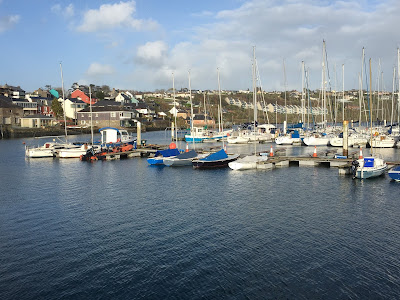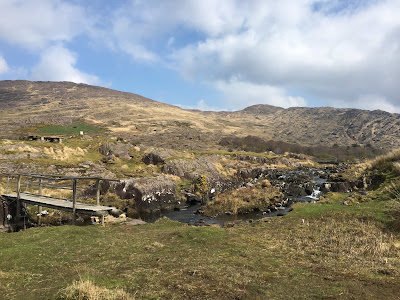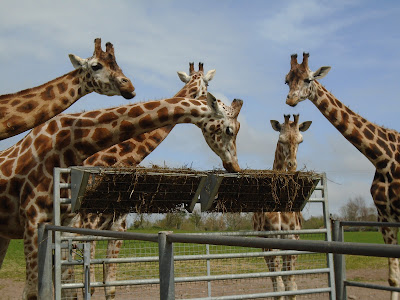I've been back from Ireland for almost a month. There have been so many welcomes back--buying coneflowers and basil to plant on the balcony, cooking spicy dinners, a few long phone conversations, petting the kitty x 10, sifting through my books on their shelves, watching the American University MFA students give their graduating readings, even a bottle of Maker's Mark (cask strength!) as an unexpected gesture of Southern-Foodways-inspired generosity. There is good to being home.
Yet Ireland is still echoing through my head; so many shades of gray, blue, and green.
Venturing to the seashore in Garyvoe, and up to the edge of the cliff all in Ballycotton, with my student on an overcast day--before we took shelter at the Jameson's distillery.
The countryside is dotted by yellow gorse, beautiful but thorny (and invasive). Another student showed me that the crushed flowers smell uncannily like coconut.
When my parents came to visit, we braved the roads in their rented car to Clonakilty and beyond to see the stones of Drombeg. We pulled up to a silent, misty field.
A small bit of signage helped us understand what we were seeing: the circle of seventeen stones oriented toward the midwinter solstice's setting sun, with a center where an urn with cremated bones had been recovered, dated to somewhere between 153 BC and 127 AD. Nearby, the remains of two small huts, plus a hearth and trough where water would have been heated by dropping in stones heated by fire.
A friend drove me to Kinsale by way of several small towns, including a stop at the ruins of Timoleague Abbey. The weather was comically rainy--great gusts pushing us as we traipsed through the soaked courtyards.
By the time we got to Kinsale, the weather (and the water) was a crystalline blue. We circled the edges of the Charles Fort.
A few weeks later, my husband and I caught the bus to Kinsale, going into the fort for an hour to explore before venturing further out to the water's edge.
From the Scilly Walk back to downtown, you can see the remains of the older James Fort--occupied by Spanish forces during the 1601 siege--on the far shore.
One of my students took us to her family's place by the shore, just outside the town of Castletownbere in the Beara Peninsula. The forecast had predicted two straight days of rain. The fates were kind and the weather cold, but clear. I come from a family of seashell-hunters and it felt right that for the first time in Ireland, I found them here.
The schedule was simply: stop for whatever beckons before the sun sets. That began with a walk along sea cliffs. My student knew the right gate to open.
We made what should have been a quick stop to see the (purported) shrine to the children of Lir, only to be gently waylaid by a pack of horses that had gotten loose.
Ireland's only cable car runs to Dursey Island. The door is secured with a latch. Emergency supplies consist of a two-way radio and a bottle of holy water.
Making our way back for the night, we saw a sign for a ring fort--a place even my student had not yet visited--and decided to check it out. Wherever there's a green ladder, you have permission to go. Just don't bother the sheep.
A new day, a new gate to open--this time to see a stone with an ogham inscription, a primitive form of Irish writing.
Our host wanted to show us Gleninchaquin lake and the Uragh stone circle, which crossed us into County Kerry. We got to the stone circle and found it overtaken by sun-lazy sheep. Slowly, surely, we negotiated with the locals for a closer look.
A week later, when another poet offered to take us anywhere we wanted to go by car, I said: "I'd like to see castles." And castles he did provide: three in one day, with a bonus spotting of a sheela-na-gig when we stopped off in the walled town of Fethard. The enclosure of Fethard probably dates to the 14th century. These female figures, with their exaggerated sexuality, date from well before that--appropriated and re-mounted into the walls. In 1990, when one disappeared from the town, the tabloid headline read "Rude Nude Stolen."
Kilkenny had the castle I'd heard about, and it probably pained my Tipperary-born host to be so set on seeing it. He patiently endured my misguided pursuits of cream ale on draft and hurling tchotchkes, steering me instead towards a a perfectly good tavern whose owner, Alice Kyteker, was convicted of witchcraft in 1324 after her husbands kept dying. Fortunately, she escaped to England before she could be burned.
The Cahir castle was the best, the surprise of the day--a beautifully preserved example of 13th-15th century defensive design. The rooms inside were stark, with stairs of varying heights designed to trip up invaders.
The portcullis is the only one in Ireland still fully operational. You've probably seen it come snapping down in a movie. A few days earlier, shooting had wrapped on scenes for The Green Knight, a retelling of the Sir Gawain myth due out in 2020.
We knew we wanted to try taking the train, and Fota Wildlife Park was an easy twenty-minute ride from the city centre. I was stunned by the extent to which the animals can roam free, and the size and the healthiness of their populations.
From there, we went on to Cobh. Don't bother, a few told us, but there's something special about this hilly, slightly dingy port city that has been a jumping-off point for so much history. We had a pint at Connie Doolan's and heard the story of how the owner had acquired the bar, after the previous owner had won it in a contest run by Guinness. I found myself in the seat frequented by "mailbag baby" Millvina Dean, who for years had been the last living survivor of the sinking of the Titanic.
My student suggested one last road trip, on the heels of our last mentoring session at Alchemy Coffee. Gougane Barra sounded modest enough--a church in a valley--but the actual site of where Saint Finnbarr took shelter, before going on to become the first Bishop of Cork, was unexpectedly moving. This lake marks the source of the river Lee.
We took one of the forest walks. Except it turned out to not be an official "forest walk" at all, but straight-up hike through private farmland--the part where we climbed a ladder should have been our tip-off. Soon the church was just a dot far below.
My first poetry teacher, Rose MacMurray, titled her book Trips, Journeys, Voyages. These are snapshots from the trips, a day or two at a time. The journey took me from D.C. to Cork and back, and it's a journey that (with any grace of luck) I'll be making again. The last time I felt this strongly about a place was Mississippi, and I wouldn't mind if they both turn out to be lifelong affiliations. The voyage is a larger one, of trying to figure out the writer I can be in this world. No map, but with the good fortune of the wind at my back, and these memories still fresh in my heart.

































































No comments:
Post a Comment